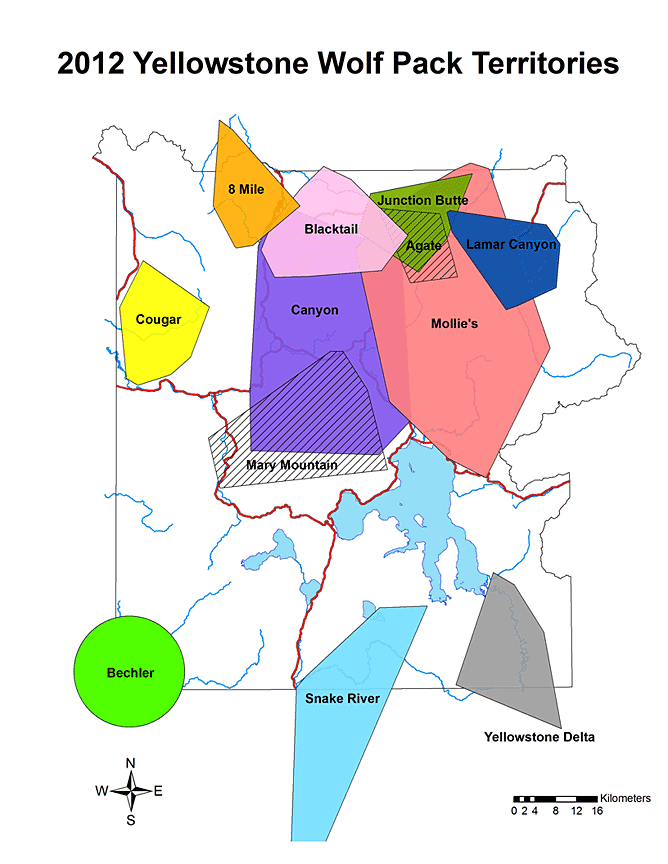
WELCOME TO
Biology 250
Worldwide, all wolves, except the red wolf (Canis rufus) of the southeastern United States, are the same species (Canis lupus). Wolves are highly social animals and live in packs. In Yellowstone, packs range from 2 to 11 individuals. Pack size varies based on the size of its main prey and adequate food. The pack is a complex social family, with leaders (the alpha male and alpha female) and subordinates, each having individual personality traits and roles in the pack. Packs generally command territory that they mark by urine scenting and howling, and defend against intrusion by other wolves (individuals or packs).
Wolves consume a wide variety of prey, large and small. They efficiently hunt large prey that other predators cannot usually kill. They also compete with coyotes (and, to a lesser extent, foxes) for smaller prey. In Yellowstone, 90 percent of their winter prey is elk; 10–15 percent of their summer prey is deer. They also can kill adult bison.
Many other animals benefit from wolf kills. For example, when wolves kill an elk, ravens arrive almost immediately. Coyotes arrive soon after, waiting nearby until the wolves are sated. Bears will attempt to chase the wolves away, and are usually successful. Many other animals—from magpies to foxes—consume the remains.
Changes in their prey
From 1995 to 2000, in early winter, elk calves comprised 50 percent of wolf prey and bull elk comprised 25 percent. That ratio reversed from 2001 to 2007. Scientists are examining why this happened and what it means. They know that bull elk are entering winter in worse condition than before. Therefore, bulls are easier to kill than before, and one bull provides much more meat than one calf or cow. Wolves may be consuming as many pounds of meat each year, but working harder for that food. When this "food stress" occurs, it can lead to increased wolf mortality— which was seen in 2008.
In the first years after restoration began in Yellowstone in 1995, the wolf population grew rapidly as the newly formed packs spread out to establish territories with sufficient prey, primarily elk. The wolves have expanded their population and range, and now are found throughout the Greater Yellowstone Ecosystem.
Disease periodically kills a number of pups. The first serious outbreak was 1999, then six years later in 2005. That year, distemper killed two-thirds of the pups. The next outbreak was just three years later, in 2008, when all but 22 of the pups died. This shortened interval concerns scientists. Infectious canine hepatitis, canine parvovirus, and sarcoptic mange also have been confirmed among adult wolves, but their effect on mortality is unknown.
Adult wolves kill each other in territory disputes. Such disputes happen each year, but increase when food is less abundant. This may have been why so many adult wolves died in fights during 2008. That year, scientists also found two wolves whose deaths were partially due to starvation.
The park's wolf population has dropped substantially since 2007, when the count was 171. Most of the decrease has been in packs on the northern range, where it has been attributed primarily to the decline in the elk population there. Disease, primarily distemper and possibly mange, have also been factors in the population decline. In most years, park staff attempt to fit enough wolves in the park with radio collars to keep track of each pack for research and management purposes. Though the number varies each year depending on population size, typically 30 percent of the population is collared by the end of the collaring season.
Wolves in the Northern Rocky Mountains have met the US Fish and Wildlife Service's criteria for a recovered wolf population since 2002. The US Fish and Wildlife Service in 2011 estimated about 1,650 wolves, 244 packs, and 110 breeding pairs in the Northern Rocky Mountain Distinct Population Segment including areas of Idaho, Montana, and Wyoming.
The gray wolf was removed from the endangered species list in 2011 in Idaho and Montana. Wolves are now delisted throughout the northern US Rocky Mountains, including Wyoming. For the first time since restoration, wolves are hunted in each state surrounding Yellowstone.
Wolf Packs in Yellowstone


By the mid-1900s, wolves
had been almost entirely eliminated from the 48 states
For a long time people believed that wolves were a danger to humans and hunted them to almost extinction.
With only so much space Yellowstone is limited to how many wolves live in the borders.
Adopt a Wolf
click the image to adopt a wolf and help protect them
Wolf Facts
Wolf pups are born deaf and blind while weighing around 0.5 kg (1 lb). It takes about 8 months before they are old enough to actively join in wolf pack hunts.
When hunting alone, the wolf catches small animals such as squirrels, hares, chipmunks, raccoons or rabbits. However, a pack of wolves can hunt very large animals like moose, caribou and yaks.
A wolf can run at a speed of 65 kilometers per hour during a chase. They can keep up a reasonable pace for hours and have been known to cover distances of 90 kilometers in one night.


